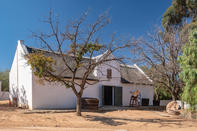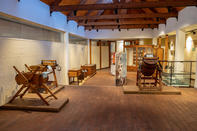Kleinplasie
Kleinplasie Museum in Worcester reflects the Breede River Valley and the surrounding region’s history through exhibitions and activities. Emphasis is placed on showcasing the agricultural industry of yesteryear in a unique open-air exhibition area. The lifestyle of the early pioneer farmers are depicted in various buildings, each a representative of a certain agricultural practice in the Western Cape during the period 1690 to 1900.
Visitors to the Open Air Museum can witness activities the pioneers participated in, including blacksmithing, bread baking, rolling and drying tobacco, soap making and grape-pressing. Other chores depicted include sheep-shearing, milking of cows, jam making and using a water mill.
Buildings to be viewed are traditional Khoi huts, a tobacco shed, townhouses and the watermill. Visitors can also take a donkey cart ride to fully embrace the olden days’ lifestyle.
Karoo Desert National Garden
Karoo Desert National Botanical Garden outside Worcester is a haven for succulent plants found in the area, of which many are rare or endangered. It is the only truly succulent garden in the Southern Hemisphere and displays one of the largest collections of indigenous succulents in the country.
The garden is 155 ha of semi-desert vegetation with over 400 naturally occurring plant species. This includes the Namaqualand flora, famous for its beautiful spring flowers. Over 300 of the species are protected and propagated in the garden.
The garden was established in 1921 but moved further north to the area of Worcester in 1945. There are various sand trails that run through the natural veld and low Karoo-type bushes, perfect for any nature-lover to explore.
Historic Buildings
Worcester has an array of houses-turned-museums that showcase the town and surrounding area’s agricultural and cultural histories. The Afrikaner Museum is housed in an old, beautiful Dutch cottage with an impressive collection of artefacts dating back to the mid-1800s. Here visitors can see the Afrikaner lifestyle, ranging from furniture to kitchenware to early surgical equipment.
Beck House Museum is in a Cape Dutch Style house built in 1841. It is now a monument and was previously the home of an important resident named Cornelius Beck. The museum depicts his life as well as Worcester’s town life in the 1800s. Visitors can see old furnishings, original doctor consulting rooms as well as small trinkets of the time.
Hugo Naude House was built in the 1900s by famous artist Hugo Naude. Visitors can explore his home and studio, where he created his masterpieces. Other displays are of contemporary South African artwork created by local artists.
The Blindiana Museum depicts the establishment of the “Instituut vir Doofstommen en Blinden”, a Dutch school for the deaf and blind built in 1881. It was founded by Dutch reformed minister Rev C. Rabie who identified the educational needs of a deaf child. The museum showcases the institute's work of braille writing and music, as well as boarding facilities, medical services and programmes for the visually impaired.


 The Route 62 Wine Route is regarded as one of the world’s best road road trips. As one of the longest wine routes known to man, this self-...
The Route 62 Wine Route is regarded as one of the world’s best road road trips. As one of the longest wine routes known to man, this self-... Worcester is a town in the Breede River Valley, situated 120 km from Cape Town. The town is located amidst the rugged Dutoitskloof Mountains...
Worcester is a town in the Breede River Valley, situated 120 km from Cape Town. The town is located amidst the rugged Dutoitskloof Mountains...